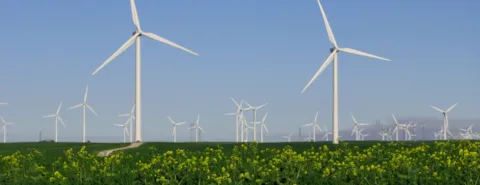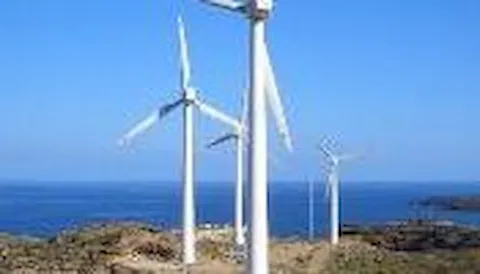Wind measurement campaigns with lidar
Leveraging lidars in wind measurement campaigns
Reliable and accurate wind and energy production assessments are essential for the long-term financial success of a wind farm. With advancements in lidar technology, this alternative to the traditional meteorological (met) mast has become an industry standard for wind resource measurements. Whether conducting energy production studies or evaluating the wind turbine performance in operating wind farms, lidars offer a reliable wind measurement solution.
How do lidars work?
A light-detection-and-ranging (lidar) device probes the atmosphere with a highly coherent laser (light) beam that transmits light at a known frequency in either a pulsed or continuous wave approach. In either case, the transmitted signal is reflected by atmospheric particulates that scatter the incident light. Some of the reflected light returns to the lidar system and is analyzed to determine the mean frequency of the return signal and the Doppler shift. This analysis results in radial wind speeds that are transformed into average horizontal wind speed, vertical wind speed, and wind direction over a given averaging period (i.e. 10 minutes).
The challenge
The use of lidars in wind resource measurement campaigns is rapidly gaining popularity. When wisely employed, they can help drive down measurement uncertainties and potential project costs. This is because the lidars are portable, can be installed in a few hours, and can measure wind data at multiple heights up to the blade tip of most modern wind turbines.
However, to optimize project uncertainties and ensure lidar measurement accuracy and reliability, one must adhere to a number of practices. For example, proper attention is required during the setup and monitoring stages of the campaign to ensure a high-quality database. Critical steps such as device performance verification, correct installation, and site selection are key to a successful lidar measurement campaign and should be handled by an experienced team.
When using a lidar for wind turbine power performance testing, the requirements set forth in the International Electrotechnical Commission (IEC) 61400-12-1 Edition 2 (2017) or Edition 3 (2022) power performance measurement standard (IEC 12-1) and associated standards IEC 61400-50-2 and 50-3 (2022) must be strictly followed to ensure an accepted test and accredited campaign.
Our approach
DNV offers a wide range of services including:
- Measurement campaigns designed to evaluate the suitability of lidar deployment and optimize measurement locations
- Turnkey lidar measurement campaigns, including installation, commissioning, operation, maintenance, and troubleshooting
- Turnkey met mast measurement campaigns, including installation, commissioning, operation, maintenance, and troubleshooting
- Measurement campaigns conducted with DNV-owned devices or external lidar devices
- Verification of the Lidar before and/or after the measurement against an IEC 61400-12-1 compliant met mast
- Wind and energy production assessment, including the evaluation of all measured data (with uncertainties, P50/P90-values, etc.)
- Access measured data and resource statistics via our online data management portal
- Turnkey IEC-compliant wind turbine power performance testing using ground or nacelle mounted lidar systems. As a global leader in quality, DNV ensures that all procedures and deliverables meet international standards and industry best practices.
DNV regional certifications:
- DNV Energy Systems Germany GmbH: ISO 17025; member of MEASNET; accredited by DAkkS for lidar verification and wind resource measurement with lidar according FGW TR6 (Fördergesellschaft Windenergie) etc., certified as an RETL by IECRE
- GL Garrad Hassan Iberica SL: member of MEASNET; accredited to ISO17025 by Entidad Nacional de Acreditación (ENAC) (for ground lidar); certified as an RETL by IECRE
- DNV Energy USA Inc.: member of MEASNET; accredited to ISO17025 by A2LA (for ground lidar); certified as an RETL by IECRE.
Why DNV?
DNV is the world’s leading independent advisor for renewable energy, offering a comprehensive range of services related to lidar measurements, including consulting, independent verification, installation, measurement campaigns, and expert reports. Our unbiased approach ensures that we recommend the optimal technology for your project, regardless of the manufacturer.
DNV operates a fleet of more than 45 lidars globally. We have an accredited test site for verifying all Lidar technologies, including vertical profilers, nacelle-mounted, and scanning Lidars.
| Question | Answer |
|---|---|
QuestionWhat are some advantages of using lidars in wind project development?
|
AnswerUsing lidar offers several advantages. They can be deployed quickly without requiring planning permission. Their installation is easier than that of a tall mast, especially in challenging terrain. Moreover, they minimize safety risks by eliminating the need for engineers to work at height. Last but not least, they have the potential to reduce uncertainties and improve pre-construction energy forecasts for sites with relatively simple terrain.
|
QuestionWhat are some limitations of using lidars in wind project development?
|
AnswerTurbulence intensities recorded with lidar devices cannot be directly used as the meaning of such measurements are not understood with respect to turbine load response and power and energy performance measurements. This is because wake and turbine loads modelling as well as performance calculations have been completed with cup anemometers that measure fundamentally different turbulent intensities primarily due to volume averaging and response to atmospheric stability. To date, there is no industry- wide consensus on how to incorporate lidar TI in current models or how to correct the lidar to a cup TI. This is in part due to the fact that each lidar model and type observe turbulence differently and therefore a universal correction method for lidars is not possible. For more information see:
|
QuestionIs it mandatory to calibrate/verify a lidar before a measurements campaign?
|
AnswerA lidar should be verified against an IEC-compliant complaint mast either onsite or offsite within 12 -months of the principle measurement campaign and in accordance with the international standard and regional best practices of the device and measurement campaign type (e.g. IEC 12-1, IEC 50-3, IEC 50-4, etc.) Before forgoing a lidar verification or only completing a post- verification, it is important to know if this skipped step will result in the exclusion of the lidar measurements. In select instances of preconstruction energy assessments, where it is not mandatory to verify or calibrate a lidar before a measurement campaign, DNV highly recommends a pre-measurement campaign verification is completed to reduce project risks and measurement uncertainties. |
QuestionHow do I include lidars in wind resource measurement campaigns?
|
AnswerThere are three primary ways to use lidars in a preconstruction energy assessment:
Met masts are reliable sources of data for wind resource campaigns, with low uncertainties (if well- designed and commissioned) and high data availability (if well- maintained). However, lidars may be more suitable in certain scenarios, such as in areas sensitive to environmental impacts or local opposition; location with tower height limits; or prospection studies where a lidar can be commissioned at several locations with relatively low commissioning labour and cost. Both technologies have their strengths and limitations, so the optimal approach is to evaluate which solution best fits each application. DNV’s expertise can help design the optimal campaign measurement combining the best of both technologies. For more information see: |
QuestionWhat is the verification/calibration process for a lidar using a met mast?
|
AnswerA lidar is verified against a cup anemometers and wind vanes on a met mast at ideally three or more identical measurement heights (and no less than two). To ensure the bestthe best correlation between the measurements, the lidar should be installed per manufacturer guidelines with a setback normally of approximately 10m. The goal of the lidar verification is to ensure proper operation and to quantify the uncertainty of lidar measurements. These uncertainties are then applied to wind measurement campaigns in a similar manor manner as an anemometer wind tunnel calibration. |
QuestionWhat are the challenges associated with the adoption of lidars in complex flow conditions?
|
AnswerDespite their many advantages, the adoption of lidars in complex flow conditions has been slow due to several challenges. Their power requirements are not trivial, and their calibration/verification is a more demanding exercise than the typical wind tunnel calibration. In complex terrain, the wind speed and turbulence intensity they return can differ significantly from those measured by a point-like device like a cup anemometer, leading to increased measurement uncertainty.
|
QuestionHow does computational fluid dynamics (CFD) help to improve the results from lidars in complex terrain?
|
AnswerCFD models have shown promise in deriving directional conversion factors that can be used to convert the lidar wind speed measurements, probed over a large volume, to point-like data, which then become comparable to cup anemometer data. DNV's approach has been validated using data from 50 remote sensing / mast pairs distributed across a range of site conditions. The use of a carefully set up, well- validated CFD model can help increase the acceptance of lidar in the context of a wind resource assessment. More information about the use of remote sensing in complex terrain with lidars: |
More information about the use of remote sensing in complex terrain with lidars
Remote sensing verification
This document explores our solutions for remote sensing verification including ground-based vertical profiling, nacelle, floating and scanning lidar verification
LiDAR for wind resource measurements
This brochure explores our solutions for wind resource measurements using lidar.
Offshore wind measurement campaigns and resource assessment
This brochure explores our solutions for offshore wind measurement campaigns and resource assessment.


